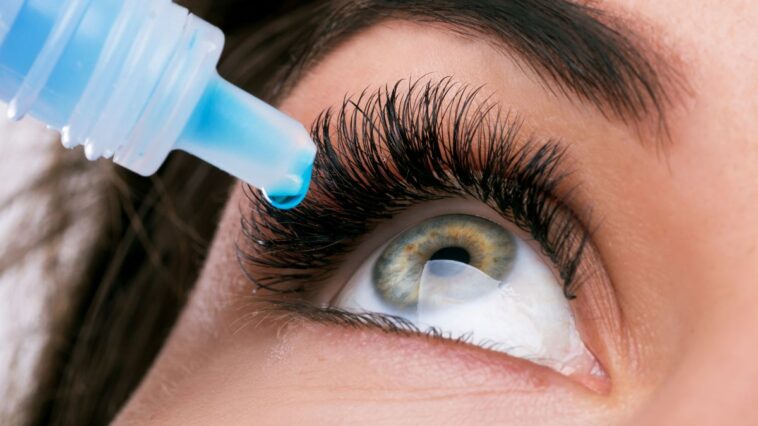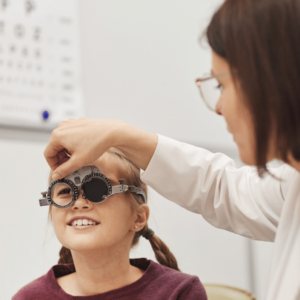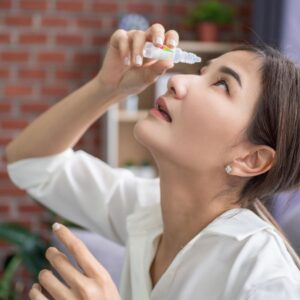What are Eye Drops?
Eye drops are a medication in liquid form that is applied directly into the eye using a dropper or other specialized device. They commonly treat various eye conditions, such as dry eye, glaucoma, conjunctivitis, and allergies.
Eye drops can contain various active ingredients, such as antibiotics, antihistamines, or steroids, and work by either moisturizing the eye, reducing inflammation, or regulating eye pressure.
How to Use Eye Drops for Dry Eyes
Here are the general steps for using eye drops for dry eyes:
- Wash your hands with soap and water, and dry them thoroughly.
- Shake the eye drop bottle or vial well before use.
- Tilt your head slightly and pull down your lower eyelid to create a small pocket.
- Hold the eye drop bottle or vial over the pocket without touching your eye or eyelid.
- Squeeze one or two drops into the pocket. Be careful not to squeeze too hard or fast.
- Close your eyes and press gently on the inner corner of your eye with your finger for about one minute. This helps to prevent the drops from draining into your tear duct.
- Wipe away any excess solution around your eye with a clean tissue.
- Repeat the process for your other eye if necessary.
- Replace the eye drop bottle cap or discard the vial as directed.
These steps are general guidelines and may vary depending on the type of eye drops you use. Always follow the instructions provided by your eye doctor or pharmacist.
Benefits of Eye Drops for Dry Eyes
Eye drops for dry eyes can provide several benefits, including:
- Relief from dryness and irritation: Eye drops can help to moisturize and lubricate the eyes, reducing feelings of dryness, itchiness, burning, or stinging.
- Improved vision: Dry eyes can blur vision or make it difficult to focus. Eye drops can improve the quality of your tears, allowing for clearer and sharper vision.
- Protection against further damage: Chronic dry eyes can lead to inflammation and damage to the eye’s surface. Eye drops can help to reduce inflammation and prevent further damage to the eye.
- Increased comfort: Eye drops can provide a soothing and cooling sensation, increasing overall comfort and reducing eye fatigue.
- Easier contact lens wear: Eye drops can moisten contact lenses, making them more comfortable to wear for extended periods.
- Convenience: Eye drops are generally easy to use, do not require a prescription, and are widely available over the counter or online.
What Are the Different Types of Eye Drops?
There are various types of eye drops available, including:
- Lubricating eye drops: Lubricating eye drops are used to relieve dryness or irritation in the eyes. These drops, also known as artificial tears, can help keep the eye’s surface moist and prevent irritation due to the lack of natural tears. They can also reduce discomfort caused by contact lenses and improve wearing comfort.
- Antibiotic eye drops: Antibiotic eye drops are specialized eye medications designed to kill bacteria in the eyes and help treat bacterial infections. These medications come in both prescription and over-the-counter (OTC) forms and can be used for a wide range of different infections. In some cases, antibiotic eye drops may be enough to treat an infection on their own, while in other cases, they may need to be used in conjunction with other antibiotics or treatments.
- Antihistamine drops: Antihistamine eye drops are a medication used to treat itchy, red, and watery eyes due to allergies. These drops contain certain active ingredients like Diphenhydramine or other antihistamines, which inhibit the action of histamines – chemicals that trigger allergic reactions. Many antihistamine eye drops are available over the counter and provide quick relief from allergy symptoms.
- Anti-inflammatory eye drops: Anti-inflammatory eye drops to treat inflammation associated with conjunctivitis and dry eye syndrome. These drops help to reduce redness and itching due to an overactive immune response in the eyes. They can also be used to treat symptoms of seasonal allergies or post-surgery inflammation.
- Glaucoma eye drops: Glaucoma is a chronic eye disease that damages the optic nerve, resulting in vision loss. Glaucoma is often treated with eyedrops that help lower the pressure inside the eye. These drops can help slow or prevent further damage to the optic nerve, helping individuals retain their vision longer.
- Steroid eye drops: Steroid eye drops are medications used to treat a variety of eye problems, such as inflammation, allergic reactions, and infections. These medications work by reducing the inflammation in the eye, which can help reduce symptoms like redness, swelling, and irritation. Steroid eye drops are usually used with other treatments for the best results.
- Mydriatic eye drops: Mydriatic eye drops are a type of medication used to dilate the pupil of the eye. These drops contain pharmacological mydriasis, which causes the pupil to expand so that more light can enter and enable a better view of the back of your eyeball when conducting an ophthalmologic exam—allowing for further detailed examination of any underlying conditions or issues.
Is It Safe to Use Prescription Eye Drops?
Prescription eye drops can be safe when used as directed by a healthcare professional. However, like any medication, there are potential side effects and risks associated with their use.
It is essential to follow the instructions provided by your doctor or pharmacist and to let them know if you experience any unusual or concerning symptoms while using the drops.
Additionally, some eye drops may interact with other medications, so you must inform your healthcare provider about all medications and supplements you are currently using. Overall, the safety of prescription eye drops depends on various factors, and it is best to consult with a healthcare professional to determine if they are appropriate for your individual needs.
How do I know if I Need Eye Drops?
There are a few common signs that may indicate that you need eye drops, such as:
- Dryness: If your eyes feel dry, itchy, or scratchy, it may be a sign that you need eye drops.
- Redness: If the whites of your eyes appear red, it could be a sign of irritation or inflammation, and eye drops may help.
- Allergies: If you experience eye allergies, such as itching, redness, or watering, eye drops designed for allergies may help.
- Contact lens discomfort: If you wear contact lenses and experience discomfort, eye drops may help to lubricate your eyes and make your lenses more comfortable.
If you experience these symptoms, you may consider using eye drops. However, if you have persistent or severe symptoms, you should consult an eye doctor to determine the underlying cause and the appropriate treatment.
Is it Necessary to see a Doctor Before Using Eye Drops?
Generally, it is not always necessary to see a doctor before using over-the-counter eye drops for minor issues such as dry eyes or mild allergies.
However, if you have a pre-existing eye condition, have never used eye drops before, or are experiencing more severe symptoms such as pain or loss of vision, it is advisable to consult with a doctor or an eye care professional before using any eye drops.
Additionally, if your symptoms persist or worsen after using eye drops, it is crucial to seek medical attention.
How to Use Eye Drops?
There are several tips to ensure the proper usage of eye drops:
- Wash your hands before using eye drops to prevent the transfer of bacteria.
- Tilt your head back and pull down your lower eyelid to create a small pocket.
- Hold the bottle or dropper close to your eye, but not touching it.
- Squeeze or instill the prescribed number of drops into the pocket made by your lower eyelid.
- Close your eyes gently and press your finger against the inner corner of your eye (near your nose) for about 1 minute to prevent the drops from draining out.
- Avoid touching the tip of the dropper or bottle to your eye, eyelid, or any other surface to prevent contamination.
- Do not share your eye drops with anyone else.
- Follow the instructions given by your doctor or the instructions on the product label, and do not use the drops for longer than recommended.
If you experience any adverse effects after using eye drops or are unsure how to use them, you should consult a doctor or an eye care professional.
Potential Side Effects and Risks Associated With Eye Drops
Like all medications, eye drops can cause potential side effects and risks, although not everyone experiences them. Some common side effects include:
- Blurred vision
- Stinging or burning sensation
- Redness or irritation
- Itching
- Dry eyes
- Watery eyes
- Sensitivity to light
- Headache
- Changes in taste
Less common but more serious side effects of eye drops can include:
- Severe eye pain
- Vision changes
- Eye discharge or crusting
- Swelling of the eyes, face, or throat
- Rash or hives
- Difficulty breathing or swallowing
- Anaphylaxis (a severe, life-threatening allergic reaction)
It’s essential to read the product label and discuss potential risks and side effects with your doctor or an eye care professional before using any eye drops. If you experience any adverse effects, you should immediately stop using the drops and seek medical attention.
How to Choose the Right Eye Drops for Your Condition?
To choose the right eye drops for your condition, follow these steps:
- Consult your eye doctor for a recommendation based on your specific condition and medical history.
- Read the label carefully to ensure that the eye drops suit your specific symptoms or condition.
- Choose a formula that matches the severity of your symptoms, such as a lubricating drop for mild dryness or an antihistamine drop for allergy-related itching.
- Consider any additional features that may be important to you, such as preservative-free options or contact lens compatibility.
- Follow the instructions carefully for proper dosage and administration.
It’s important to note that self-diagnosis and self-treatment may not be practical or safe. Always consult a medical professional before using any medication.
Get Helpful Tips and Tricks For Long-Term Relief from Dry eyes.
If you suffer from dry eyes, here are some tips and tricks for long-term relief:
- Stay hydrated by drinking plenty of water and other fluids.
- Use a humidifier to keep the air moist.
- Take frequent breaks from screens and devices, and practice the 20-20-20 rule (look away from your screen every 20 minutes for 20 seconds, and focus on an object 20 feet away).
- Wear sunglasses or other protective eyewear to shield your eyes from wind, dust, and sunlight.
- Avoid cigarette smoke and other irritants.
- Use artificial tears or lubricating eye drops as directed by your doctor or pharmacist.
- Adjust your diet to include foods high in omega-3 fatty acids, such as salmon, tuna, and nuts.
- Treat any underlying medical conditions that may be contributing to your dry eyes.
- See your eye doctor regularly for checkups and to monitor your condition.
Remember, chronic dry eyes can be a symptom of an underlying medical condition. If your symptoms persist, consult your eye doctor or ophthalmologist to determine the underlying cause and develop an appropriate treatment plan.
Conclusion
Eye drops are a common and effective treatment for dry eyes. When choosing eye drops for dry eyes, it is essential to consult a doctor or pharmacist to determine the most appropriate formula for your specific symptoms and medical history.
Additionally, it’s essential to carefully read the label and choose a formula matching your symptoms’ severity. Regular eye drops, as directed, along with other lifestyle changes, can help provide long-term relief from dry eyes.
It’s important to note that self-diagnosis and self-treatment may not be practical or safe, and it’s always best to consult an eye specialist before using any medication.






